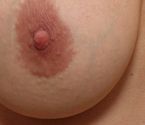Nipple Reduction Chicago


* Individual results may vary.
Photo Gallery
View before-and-after pictures of real patients of Dr. Laurie A. Casas
Nipple correction candidates are men or women who feel their nipples are too large. During your initial consultation, Dr. Casas will review your options for altering the appearance of your nipples. During the consultation, Dr. Casas will also go over what you can expect during and after your operation. You’ll have a complete understanding of the procedure, how to manage recovery, and what your results should look like at the end.
Childbirth and nursing can cause the nipples to lengthen, making them difficult to conceal under normal clothing. Nipple projection can be reduced through an incision around the nipple that removes nipple skin. This can help create a newfound sense of comfort and self-confidence that may have been missing before.
The nipple can be pushed in and sutured in a less projecting position so that, once healed, they are less obvious through normal clothes. The ability to nurse (breastfeed) can be preserved using this method. Dr. Casas performs this procedure under local anesthesia, and you can expect to resume normal activities the same day while protecting the nipple incisions for two to four weeks. It may take up to six weeks for some patients to fully recover, depending on their particular situation.
As many as 10% of women have inverted nipples. In her article, “Aesthetic and Predictable Correction of the Inverted Nipple” (Aesthetic Surg J 2003;23:353-6), Dr. Casas describes her technique for correcting nipples that will not become erect. This procedure is typically performed to correct severely inverted nipples. Such cosmetic issues can do a number on people’s self-confidence and, in some cases, cause a noticeable discomfort that affects a person’s day-to-day life.
As many as 10% of women have inverted nipples. In her article, “Aesthetic and Predictable Correction of the Inverted Nipple” (Aesthetic Surg J 2003;23:353-6), Dr. Casas describes her technique for correcting nipples that will not become erect. This procedure is typically performed to correct severely inverted nipples. Such cosmetic issues can do a number on people’s self-confidence and, in some cases, cause a noticeable discomfort that affects a person’s day-to-day life.
Usually, while under general anesthesia, a small incision is made along the areola. Dr. Casas then releases the fibers that tether the nipple, preventing it from becoming erect. The inside of the nipple is sutured together so that the nipple remains erect. The areola incision is closed, and the patient wears a pad over the incision for a few months to protect the nipple. Normal activity can be resumed in a few days, with minimal discomfort throughout the healing process.
Nipple Reduction Patient Testimonial
“After breastfeeding 4 children, I found myself wearing nothing but black to the gym to deter any stares to my breasts. Though the best thing for my babies, it was not for my breasts! Breastfeeding left my nipples elongated and embarrassingly looking like I was “cold” all the time. I consulted with Dr. Casas about having a nipple reduction and was surprised to find out it was an easy in-office procedure. After my procedure, the recovery was very easy and relatively painless. I endured more pain while breastfeeding! My anxieties about what to wear to the gym or any other time are gone. I am very happy with my result. Thank you, Dr. Casas!”
Who are Good Candidates for Nipple or Areola Reduction Surgery?
Due to the surgical nature of the procedure, the patient must be in good health before proceeding. The operation is viable for both men and women looking to reduce the size of their nipple or areola. Patients commonly opt to combine the surgery with breast augmentation services, as they go hand in hand with the cosmetic appearance of the area in question.
Different approaches can be used to achieve the desired outcome, whether it‘s reducing the diameter of the areola or reducing the overall length of the nipple. This cosmetic surgery is beneficial for those who are unhappy with how that part of their body looks or who experience a degree of discomfort from the localized area.
Women who are pregnant or are actively breastfeeding are highly advised to stay away from this procedure, as the body can drastically change during this period and reverse the work that went into the surgery.
Many people may seek out surgery to improve their self-confidence, and it’s important to remember that a surgeon may be able to change the way you look, but they can’t help much with tackling self-confidence. A healthy body is essential, but a healthy mind has equal weight in the equation.
Although women and men alike can benefit from the surgery, it’s more commonly performed on women due to the physical changes that can occur with pregnancy and breastfeeding and in some women it can occur from puberty. As with any surgery, there are minor risks your surgeon will discuss with you, but the procedures discussed in this article are known to be relatively low risk.
What You Can Expect
Nipple or areola reduction seems like a simple surgery from an outside perspective, but it comes with its own set of considerations that are important to understand before diving in head first. It all starts with a consultation to determine the specifics of what you want to achieve from the surgery. Once it’s time to start, a surgeon will mark the requested areola size, and the excess within the area is excised to bring the skin together.
With nipple reduction surgery, your surgeon will remove a ring of skin from the base of the nipple and close that gap with dissolvable stitches. Typically nipple reduction surgery is performed under local anesthesia with mild sedation. This procedure typically takes 30-60 minutes per side.
Most people are usually concerned with the surgical procedure itself, but it’s also important to clearly understand how the healing process works. As the surgery focuses on a small area of the body, it’s pretty easy to go about your daily activities while you heal.
You’ll be instructed on how to properly protect the area while it heals, and most people don’t suffer much discomfort after the operation. Every patient’s journey is different, but most people can expect to fully heal within about six weeks of their procedure.
How to Choose a Plastic Surgeon for Areola or Nipple Reduction Surgery
Regardless of how minimal the surgical procedure is, you should only work with a surgeon with the proper qualifications and a positive reputation. Although medical certifications go a long way, equally important is how the surgeon treat their patients. Nowadays, you can easily find reviews on medical professionals, and it’s best to read up on previous patients’ experiences if possible.
Areola and nipple reduction surgery requires an impressive level of precision and a steady hand. Make the most of your initial consultation, as this will give you a good look into the surgeon as a professional and a person. Never cut corners when placing your health in someone else’s hands. Even though most people are looking for a cosmetic change, you shouldn’t ignore the potential health risks associated with the surgery.
You should also ensure your surgeon understands why you want a smaller areola, as this will give them a thorough idea of how you view your body and the operation itself. A healthy body is important for a successful surgery, but a healthy mind is more important to body image and self-confidence. No matter what you discuss in your consultation, you should feel confident that your surgeon understands your needs and is capable of achieving your desired outcome.
Although certifications and reviews look nice, it doesn’t hurt to question a surgeon’s hands-on experience with the procedure. Training goes a long way, but those who have been there and done that are usually better suited to the task. Although the surgery is relatively quick, you should spend considerable time vetting the surgeon you choose to perform your operation.
Our patients work with us in confidence, knowing that we understand all the pros and cons associated with nipple or areola reduction surgery. We leave zero room for mistakes and ensure every patient’s questions are answered well before the operation takes place.


